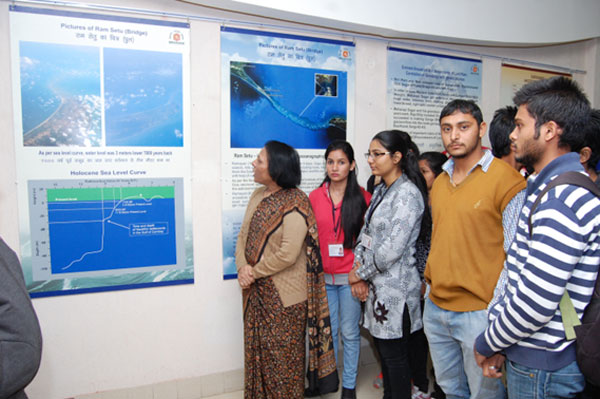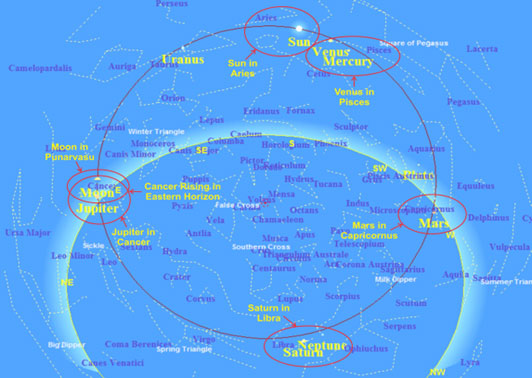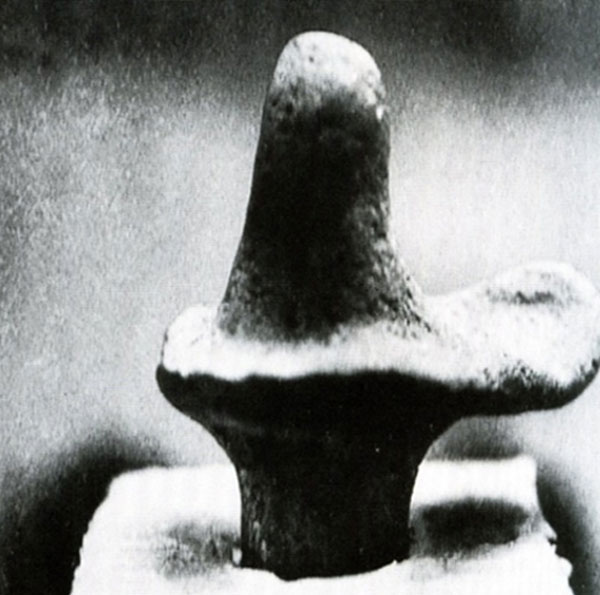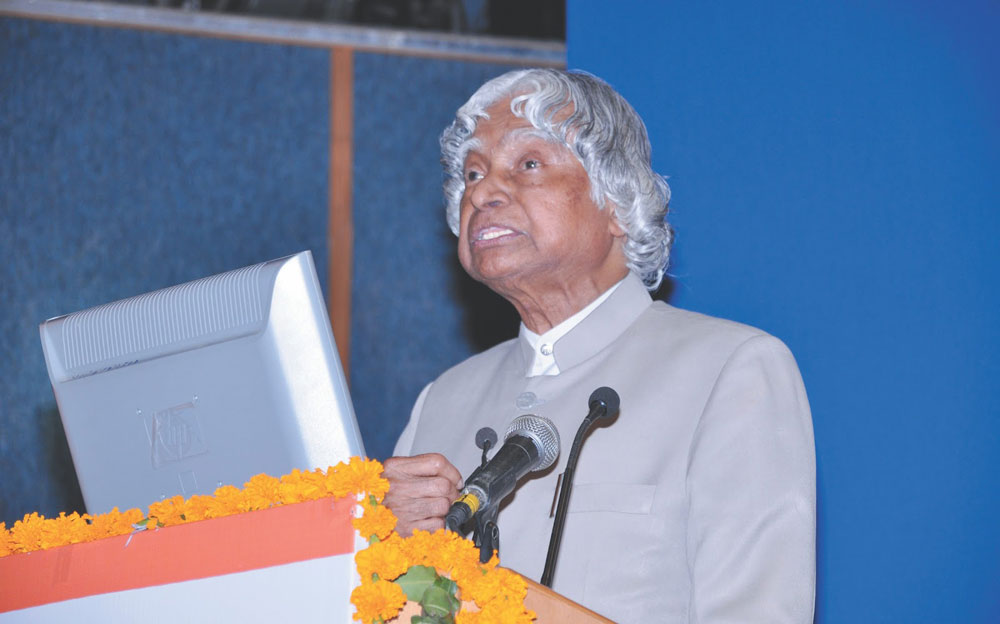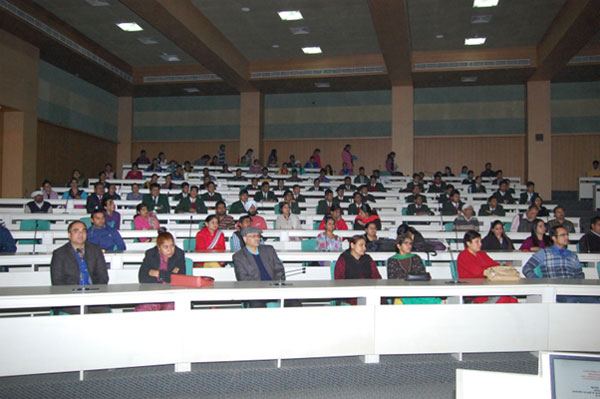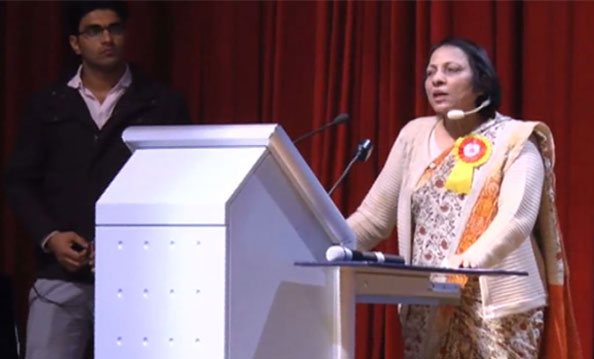Exhibition On Cultural Continuity from Rigveda to Robotics,
3rd - 4th February, 2016 at GJUS&T, Hisar
Exhibition-cum-Seminar on Cultural Continuity from Rigveda to Robotics in GJ University of Science and Technology; Chaired by Prof. Kaptan Singh Solanki, Honourable Governor of Haryana; Co-chaired by Prof. Tankeshwar Kumar, Vice Chancellor
(A brief report)
This unique Exhibition was put up by I-SERVE Delhi Chapter on 3-4 February, 2016 in the beautiful Arch-gallery of the grand auditorium complex of Guru Jambeshwar University of Science and Technology, Hisar. The objective was to showcase the outcomes of multi-disciplinary scientific research carried out for more than 12 years for the benefit of students and teachers of modern sciences. The Exhibition was unveiled by Prof. Kaptan Singh Solanki, Honourable Governor of Haryana.
For the Seminar, an invited lecture on the subject was delivered by Smt. Saroj Bala, Director of I-SERVE Delhi Chapter. Dr Ankit Agarwal, advisor of the I-SERVE Delhi Chapter delivered a talk on ‘Story of Saraswati through Scientific Evidence’. Dr Bandana Pandey, Director of HRDC in GJU introduced the guests and set the tone for the event with her vibrant, beautiful words.
A special address was delivered by Dr Tankeshwar Kumar Ji, Hon’ble Vice Chancellor of GJU, who was the moving force behind this event. Honourable Governor delivered the valedictory address. He wholeheartedly appreciated the quality and output of research undertaken by Saroj Bala and the team of scientists from the I-SERVE Delhi Chapter.
Welcome address by Shri Harish Bhimani of Mahabharat TV Serial fame: for audio
The theme of the Exhibition on Rigveda to Robotics
The Exhibition was put up on 3-4 February 2016 in the beautiful Arch-gallery of the GJU auditorium complex. GJU is the proud owner of a 2000-seater state-of-the-art Auditorium Complex which is no less than Vigyan Bhawan of Delhi. The theme as well as the format of the Exhibits was unique as the extracts from Valmiki Ramayan were displayed along with corresponding sky-views, archaeological exhibits, and details about Ramsetu. Through these Exhibits it was proved that:
- The latest scientific research reports have proved that indigenous civilisation has been developing in India for the last 10,000 years. Vedas contain references to the sky views which could be observed around 9000 - 7000 BP, Ramayana refers to the sky views seen sequentially around 7000 BP, whereas those of Mahabharata could be observed around 5000 BP.
- On display were the sky views, generated by using Planetarium software, starting with the one observed at the time of birth of Lord Ram in 5114 BC, matching exactly the description given in Valmiki Ramayan. All subsequent sky observations of important events in the life of Lord Ram reveal perfect chronological matching.
- The sky views generated by using Planetarium software, which match the references in Mahabharata sequentially right from the date of departure of Pandavas for thirteen years of exile, after they lost everything in the game of Dice in 3153 BC, to the sequential events leading to Mahabharata war in 3139 BC and thereafter right up to the solar eclipse seen from Dwarka before it submerged 36 years after Mahabharata war in 3103 BC.
- These astronomical dates of references in Rigveda, Ramayana and Mahabharata are corroborated by oceanographic, archaeological, geological, remote sensing, palaeobotanical, ecological and anthropological evidence. Various exhibits displayed provided a pictorial glimpse of such scientific evidence. The archaeological proofs displayed were in the form of utensils, ornaments, weapons, plants, infrastructure etc. These support the astronomical dates of references in these scriptures.
- A map showing more than 150 places visited by Shri Ram during his exile was also displayed. One could look at the picture of Kotumsar caves in Dandak Vana; the carbon dating of grains found from there has proved that these are 7000 years old! Also on display was the map showing kingdoms and tribes which participated in the Mahabharat war; these extended from Gandhar in Afghanistan to Trikut in Sri Lanka and from Lauhitya (Arunachal Pradesh) in the East to Dwarka in the West! Should not we describe these as part of the territory of Greater Bharat Varsha?
- Some rare pictures of Ramsetu were on display with proof that it was at the walkable level around 7000 years back. Put on show was the pictorial display of the eventful journey of the remote past revealing how and when Ganga became the most venerated holy river of India in place of Saraswati!
- The genealogy charts of the Suryavanshi rulers, containing names of 63 predecessors and 59 successors of Lord Ram were on display. These were corroborated by the latest DNA studies, particularly of Ramayan tribes, revealing the genetic continuity of civilised populations for more than 10,000 years in India and the common genetic heritage of Dravidians, North Indians and Tribes in which there has been no inflow during the last 10000 years but there has been outflow, giving a final burial to Aryan Invasion Theory.
- There are a larger number of scientific discoveries and lesser number of inventions recorded in Vedic and post-Vedic literature. Some such discoveries were also showcased. References to various discoveries of Physics, Chemistry, Botany, Astronomy, Mathematics, Environmental Sciences etc. were described in greater detail during the presentation by Saroj Bala.
Have a glimpse into some of these -
In this vibrant atmosphere, Dr Bandana Pandey, Director of HRDC of GJU started her address with ‘नमस्ते सदा वत्सले मातृभूमे’. She gave a very interesting introduction of all the distinguished guests, besides giving a short overview of the subject. Then she invited Mrs Saroj Bala to make the much-awaited presentation. Smt Saroj Bala started her presentation with a huge applause from 2000 strong presence of listeners.
Smt. Saroj Bala started her address by asserting that multi-disciplinary scientific Research has revealed that the Vedic Civilization has been developing indigenously in India for more than 9000 years. There is no scientific evidence of any Aryans ever coming from outside. Thereafter she explained all the details with the help of sky views and images as under –
- It was observed that the astronomical references in Rigveda represent the sky views of dates belonging to the period 7000 BC to 5500 BC & those mentioned in Ramayan referred to sky views seen sequentially on dates around 5000 BC. Most of the astronomical references/planetary configurations around the Mahabharat war, narrated in Mahabharat, could be observed in the sky sequentially around 3100 BC.
- The corroboration of such astronomical dates by multidisciplinary scientific reports is simply amazing! Recent archaeological reports of excavations around Indus, Saraswati & Ganga River systems have been examined. The artefacts found fully matched descriptions of such articles in Vedas & Epics and their carbon dating placed them as belonging to the period 9000 BP to 5000 BP. Remote sensing images of ancient channels of the Saraswati River system corroborate references in Vedas and Epics. Some very interesting examples are given below –
- References to houses, bricks, boats, and terracotta figurines etc. were extracted, many of which were supported by archaeological reports from sites excavated around the Indus, Saraswati & Ganga River systems.
- References of plants, trees & herbs from Vedas and Epics were extracted. When these were compared with palaeobotanical reports, an unbelievable correlation was found, which revealed that many of these have been in existence in India for the last 5000-8000 years.
- References to weapons, metallurgy, pottery & jewellery extracted from Vedas and epics not only matched with such items found during excavations but also gave the historical perspective of the materials & designs of such products.
Swastika motif engraved on a seal, Mohenjo-Daro Terracotta Linga-come-yoni, Kalibangan
- References to fluctuating water volumes of rivers like Saraswati, Indus, and Ganga, were extracted sequentially. The reports from Remote Sensing, Geology and Hydrology of such fluctuations corroborated our astronomically determined dates of Vedas and epics.
- References to submerged or re-emerged islands & structures (like Ram-setu) have also been corroborated by reports from the National Institute of Oceanography, Goa & Marine Archaeology Department.
Smt. Saroj Bala also provided a very credible reinterpretation of the Yuga System. Finally, expressing gratefulness to Dr Kalam for the inspiration and guidance provided by him, she concluded by saying that all scientific proofs led to the conclusion that cultural heritage coming from Vedic times has continued to develop through the ages, adapting and changing with times but preserving the core values and systems
To have a look at the PPT of Presentation on Cultural Continuity from Rigveda to Robotics –
To watch the video of her presentation, click here -
To watch the video of her presentation
For more information and videos on the subject visit -
https://www.youtube.com/c/RigvedatoRobotics/videos
Dr Tankeshwar Kumar, Vice Chancellor of GJU impressed the audience with his deep knowledge of the subject combined with his in-depth knowledge of Modern Sciences, especially Physics. He said that –
- The intensive and extensive scientific research, which has gone behind this Exhibition and Seminar on ‘Cultural Continuity from Rigveda to Robotics’ has proved that Rigveda was composed more than 9000 years ago and there has been cultural continuity since then.
- Ancient scholars and Rishis-Munis of ancient India had such profound knowledge of astronomy and methods of time reckoning that modern scientific tools are establishing their precision and reliability. We need to know all that in greater detail for our own benefit.
- Dr Tankeshwar Kumar, Vice Chancellor of GJU appreciated the initiative taken by Mrs. Saroj Bala and her Institute I-SERVE. He requested that various science departments of GJU take the initiative in correlating and carrying forward ancient knowledge of modern sciences. He also endorsed the idea of having co-guides from the faculty of sciences with Sanskrit scholars of the Department of Religious Studies of GJU.
Finally, Prof. Kaptan Singh Solanki, Honourable Governor of Haryana came to the Dias and delivered his much-awaited address. He heaped very lavish praise on Mrs. Saroj Bala and her team for doing research which has increased our pride in our Nation’s rich and most ancient cultural heritage. He went to the extent of suggesting that all MPs should know the facts revealed through the Exhibition and the Seminar. Look at some extracts –
The proofs displayed through this exhibition and presented during the Seminar are so convincing and credible that it may not be possible to say any more that Ramayana and Mahabharata are mythology. It has been proved that these contain references to true events of the remote past; the true dates of these events can be determined by making use of modern scientific tools. Full-fledged efforts need to be made so as to reach the information revealed through this Exhibition and Seminar to the largest number of people all over India; rather all over the world.
Prof Solanki lamented that due to India being ruled by Mughals and Christians, our history has been distorted beyond recognition. Then the leftists took over the charge of writing and teaching History in India and demeaned as well as destroyed it beyond recognition. Tribals have been called Adivasis instead of describing them as Vanvasi. We are all Adivasis living in Bharat Varsha for 9000 years and developing our civilization indigenously. The Hon’ Governor added that after hearing Mrs Saroj Bala’s lecture and after watching the Exhibits, do not let anyone describe you as immigrants but announce with pride that we are the original inhabitants of India. Do watch the Video Recording of the Honourable Governor’s address –
Address By Prof. Kaptan Singh Solanki, Honrable Governor of Haryana-
For more information and videos on the subject visit -
https://www.youtube.com/c/RigvedatoRobotics/videos
During this Exhibition, one could also watch the video recording of address by late Dr A.P.J. Abdul Kalam, most admired ex-President of India, talking about such indigenous development of civilisation, relating the Ramayana references to 7000 BP and extolling the scientific achievements of India in remote past! An extract is as under-
“Vedic and post-Vedic literature has a tremendous amount of scientific knowledge which will be extremely beneficial to humanity. For creating a faith in these documents, there is a need to establish the date of occurrence of Vedas and Upanishads which are contained in our mythology, so that they are transformed into historical events and not imaginary mythological events…….
If we look at the study on scientific dating of Ramayana, the important aspect about the Ramayana is that when Valmiki wrote the epic, he made it with many proofs. He packed so much information about the various planetary positions of those days, the geography of the areas mentioned in the epic, the seasonal events, and about the genealogy of various kings that it is virtually a no-brainer to establish the dates on which those events occurred.
Astronomical calculation, making use of planetarium software, have proved that events narrated in Valmiki Ramayana actually occurred around 7000 years back and they can be sequentially dated. Ramsetu is found submerged at the same location as is described in Valmiki Ramayana and the city of Dwarka has been explored by marine archaeology wing of Govt of India….
As per the estimate made by the Inter-Governmental panel on Climate Change (NASA, Global Change Master Directory), the rise in the sea level during the last 7000 years has been about 2.8 meters which roughly corresponds to 9.3 feet. The remains of Rama Sethu are found submerged nearly at a depth of 9-10 feet. Thus, obviously this bridge was capable of being used as a land route 7000 years back. This is the only existing evidence on manmade bridge so many thousands of years back…
It is essential that our researchers launch a mission-oriented program in an integrated way by earth science, geological science, remote sensing and space scientists, oceanography and climate change teams and the people who are engaged in construction under the sea….
Almost all the visitors, teachers and students showed deep interest in the subject, lectures as well as Exhibits. They made extremely positive and encouraging comments about the Exhibition as well as the Seminar. A Quiz Program on the subject was conducted on 4th February, in which more than 300 students had participated. These students showed keen interest, displayed good knowledge of the subject and consequently won many prizes during this Quiz Program. Normally such enthusiasm about learning anything new is very rarely seen amongst the students.
Formal and informal interaction with the faculty members of GJU revealed that some of them were really interested in unearthing and connecting the scientific knowledge of ancient India with modern sciences in certain selected areas with the following objectives –
- Make our rightful claim over the scientific theories and discoveries made by us, e.g., in subjects of astronomy, metallurgy and medicine. Write the true history of sciences by keeping future needs in mind.
-
Take up individual research in selected science subjects; starting from ancient knowledge, its development in modern times and identifying the scope for carrying the research to logical conclusion by working on an identified component in the best interest of mankind, e.g., one or two out of 121 surgical instruments listed in Charak Samhita or a weapon for making crowds unconscious (without killing), described in Mahabharata, may still have the potential of being developed.
- Faculty of Medical Sciences; Physiotherapy – Tracing the history of Yoga with credible dating, developing a model for future by integrating some inputs from modern physiotherapy.
- Writing the history of various sciences, taking very specific subjects – these projects can be done jointly with inputs from Sanskrit scholars who have scientific mindset. Dr Bishnoi, Chairperson of Department of Religious Studies, has already been collecting such information and fully supports the idea.
- Preparing comprehensive list of Sanskrit manuscripts (their number is in lacs), lying in foreign countries and getting the list of those which contain ancient knowledge of sciences made with a short description.
Deep interest was also shown by print and electronic media and I-SERVE team felt encouraged with the positive coverage from them as they generally endorsed the authenticity as well as the credibility of the theme of the exhibition and trustworthiness of the contents of its exhibits. Many newspapers / magazines covered the news of this unique exhibition.
Before departing, Mrs Saroj Bala requested Shri Tankeshwar Kumar Ji VC and his team to carry forward the subject by way of enrolling some students for doing PhD in this subject of multi-disciplinary scientific research. She also requested them to enjoy shared pride in their rich cultural heritage, ignoring as well as eliminating all kinds of artificial divisions created on the basis of castes, sub castes and tribes.
The most striking feature about the faculty, students and management of GJU was their patriotic spirit and their keen desire to know about the antiquity and richness of our ancient scientific knowledge!





